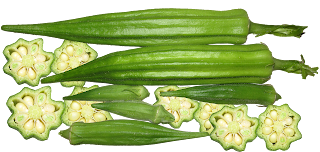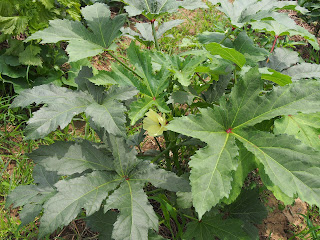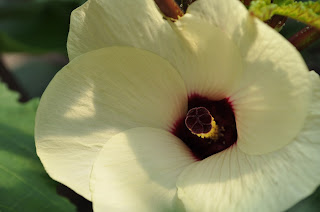horticulture guruji
Okra /Lady's Finger Cultivation
Okra (Abelmosus esculentus) is also known as Bhindi in India. Okra is an important summer vegetable, which is well-liked with spicy vegetables and soups. Okra seeds are rich in protein and are used to make edible oil. Okra is rich in vitamins, calcium, potassium and other minerals. It is a rich source of iodine content which helps in goiter. India is a major country in the production of okra. In this chapter, you will learn its cultivation.

Other Names:- Bhendi, Lady’s Finger
Botanical Name:- Abelmoschus esculentus
Family:- Malvaceae
Chromosome Number:- 2n=130
Origin:- Africa.
Important Point
- Okra is a day-neutral crop
- Okra is often cross-pollinated crop
- India is the largest producer of okra in the world.
- Okra contains higher Iodine content which helps in goitre.
- The major breeding objective is to develop varieties resistant to Yellow Vein Mosaic Virus (YVMV).
- Systemic research work is started by Dr Harbhajan Singh.
- High temperature (Above 42oC) cause flower bud drops.
- The export standard size of okra is 6-8cm. long fruits.
Watch Lecture Video


Area and Production
|
Sr. No. |
States |
2018 |
|
|
Area (000ha) |
Production (000MT) |
||
|
1 |
West Bengal |
77.55 |
914.86 |
|
2 |
Gujarat |
75.27 |
921.72 |
|
3 |
Odisha |
64.07 |
566.88 |
|
4 |
Bihar |
57.41 |
787.78 |
|
5 |
Madhya Pradesh |
43.76 |
638.34 |
|
6 |
Chhattisgarh |
30.88 |
323.24 |
|
7 |
Haryana |
24.53 |
233.96 |
|
|
Other |
135.55 |
1708.16 |
|
|
Total |
509.02 |
6094.94 |
Economic Importance
- Okra contains 89 grams of moisture, 10.4 grams of dry matter, 1.9 grams of protein, 66 grams of calcium, 1.5mg of iron, 0.07mg of thiamin, 0.10mg of riboflavin and 13.0 mg of vitamin C each of 100g of the consumable portion.
- Green fruits are added to curries and also used in soups.
- In the preparation of jaggery, root and stem are used to clean the sugarcane juice.
- Stems containing crude fibre are used in the paper industry.
- Dried seeds contain 13–22% edible oil and 20–24% protein.
- The seed cake is used as an animal feed.

Climate
Okra is a crop of tropical climate and requires warm humid climate for best production. It is susceptible to drought and low temperatures (frost). The optimum temperature for okra crop is 20-30oC. For seed germination, a temperature range between 25 and 35oC is required. When in summer temperature goes above 42oC flower buds drop causing yield losses.
Soil
It can be cultivated in all type of soils from sandy loam to clay. However, for good yield loose friable, well manured loamy soils having better drainage. The soil optimum pH for okra is 6-6.8.
Varieties
- Introduction
- Perkins Long Green:- Suitable for North Indian Hills
- Clemon’s Spineless
- Selection
- Pusa Makhmali
- Gujarat Bhindi No.1
- Co-1
- Hybrids
- Pusa Sawani :- Pusa Makhmali X IC 1542, Spinless, suitable for larger range of pH and tolerant to salinity.
- Arka Anamica:- esculentus X A. manihot spp. tetraphyllus
- Arka Abhay:- esculentus (IIHR 20-31) X A. manihot spp. tetraphyllus, it is sister line of Arka Anamica, quick branching after pruning.
- Punjab Padmani:- esculentus X A. manihot spp. manihot resistant to YVMV and tolerant to jassids and cotton boll worm.
- Parbhani Kranti:- esculentus cv. Pusa Sawani X A. manihot spp. manihot
- Punjab -7:- esculentus cv. Pusa sawami X A. manihot ssp. Manihot
- Varsha Uphar (HRB 9-2): Lam selection 1 X Parbhani Kranti, resistant to YVMV and tolerant to leaf hopper
- Hisar Unnat (HRB-55): Selection 12-2 x Parbhani Kranti, resistant to YVMV, early variety.
- Panchali
- Adhunik
- Supriya
- Varsha
4. Mutant
- MDU1 :- from Pusa sawani
- EMS 8
- Punjab-8(EM 58): from Pusa sawani, resistant to YVMV and tolerant to fruit borer.
5. Yellow Vein mosaic virus resistant
- Arka Anamica
- Arka Abhay
- Hissar Barsati
- Varsha Upkar
- Pusa Sawani
- Punjab Padmani
- Prabhani Kranti
- Co-1:
- Azad Kranti
- Pusa A-4: resistant to YVMV and tolerant to jassids and shoot and fruit borer, quick branching after pruning.
Sowing time
- In plains, sowing is done in February-March for spring-summer crop and June-July for rainy season crop.
- The crop sown earlier in season will be less affected by YVMV than July.
- In a hilly region, the crop is sown from April to July.
- In South India, it can be sown around the year, because of mild climate.
Seed rate
- The seed rate is 18-22 kg/ha for spring-summer crop and 8-10 kg /ha for rainy season or Kharif crop.
Field Preparation
Soil should be plough once with soil turning plough then 3-4 time with desi plough or cultivator. At last ploughing 20-25 tons /ha, FYM added to the soil.
Seed sowing
Seeds are sown directly by seed drill, hand dibbling in flatbeds. Seeds are also sown on ridges it ensures proper germination; economic use of irrigation and helps in drainage during the rainy season.
Spacing
For branching type, a plant spacing is kept 60 X 30 cm, while for non-branching type 45 X 30 cm. During spring-summer season due to less plant growth spacing is kept at 45 x 20 cm or less.
Nutrition
The dose of manures and fertilizers depend upon the type of soil, generally, 25 tonnes/ha of FYM should be added at the time of the last ploughing. In addition to this, 125kg/ha N, 75kg/ha P and 63 kg K/ha will be required in medium nutrient soils. A full dose of P and K and a half of the nitrogen should be applied as basal dose at the time of sowing while the remaining half of the nitrogen should be given as top dressing 35-40 days after sowing.
Irrigation
During the rainy season, irrigate the crop as and when required. In spring and summer season the crop should be irrigated at an interval of 4-5 days. Drip irrigation is more beneficial in okra as compare to flooding. It increases considerable yield and saves 75-80% irrigation water.
Weed control
About 2-3 weeding are required in the initial stage. Weedicides like Basalin @2.5 litres a.i/ha as pre-sowing soil application and Lasso @ 5-litre a.i/ha as post sowing gives the best control to a maximum number of weeds.
Use of chemicals and growth regulators
|
Sr. No. |
Chemical and PGR |
Doses |
Effectiveness |
|
1 |
Cycocel |
100 ppm (seed soaking for 24hrs) |
Increase fruit set and yield |
|
2. |
GA3 |
400 ppm (Seed Treated) |
enhanced germination |
|
3. |
IAA |
200 ppm (Seed Treated) |
enhanced germination |
|
4 |
NAA |
20ppm (Seed Treated) |
enhanced germination |
|
5 |
Ethephon |
100-500ppm |
reduced vegetative growth and apical dominance |
Harvesting
Fruits are ready for harvesting 7-8 days from flowering. The fruits should be harvested when they are immature, green and have 8 to 10cm. size. In general, harvesting is done at an alternate day. Delay in harvesting causes fibrous and poor edible quality.
Yield
An average yield of 60-65 q/ha green fruits during spring-summer and 90-120q/ha during the rainy season.
Physiological disorder
Poor Seed Germination
Seed germinate is poor when soil temperature remains at or below 150C. The problem occurs during early spring crops cultivation when seeds are to be sown at the low-temperature condition.
Management
- The seeds are soaked in water for 24 hours.
- The seeds are soaked in hot water at 450C for 1 -2 hours.
- For half an hour seed should be treated with alcohol.
Insect Pest and Management
- Stem and fruit borer (Earias vittela):- The caterpillar of the insect feed on growing points of the plant and bore the flower buds and young fruit.
Control
- Spraying the crop with 0.1% Carbaryl or Monocrotophos 0.1%.
- Jassids or Leaf hoppers (Amarasca biguttula):- This is a serious pest of okra. They suck the sap from the tender leaves, causing curling of leaves and burning effects on the edges.
Control
- Spray crop with phosphamidon or oxy methyl demetone 0.5%.
- Leaf Weevil: – The adult of the pest eats leaf tissue and making holes.
Contol
- Spray the crop with 0.1 % Monocrotophos or Rogor or Parathion.
Disease Management
- Powdery Mildew: – Initial symptoms are shown on the lower surface of the leaves as blotches of white powdery coating appears. Later leaves turn yellow and drops.
Control
- Spray as soon as the disease is noticed with 30 gm. Wettable Sulphur or 5ml Dinocop in 10 litres of water.
- Yellow Vein Mosaic Virus: – This is a serious disease of okra which is transmitted by whitefly. Leaves, as well as fruits of the plant, turn yellow and fruiting also affected.
Control
- Uproot and destroyed the affected plant as soon as noticed.
- Grow disease-resistant varieties like Pusa sawani, Arka Anamica, Arka Abhay, Hissar Barsati, Varsha Uphar etc.
- Control vector by spraying crop with Monocrotophos 0.1% or Dimethoate.
